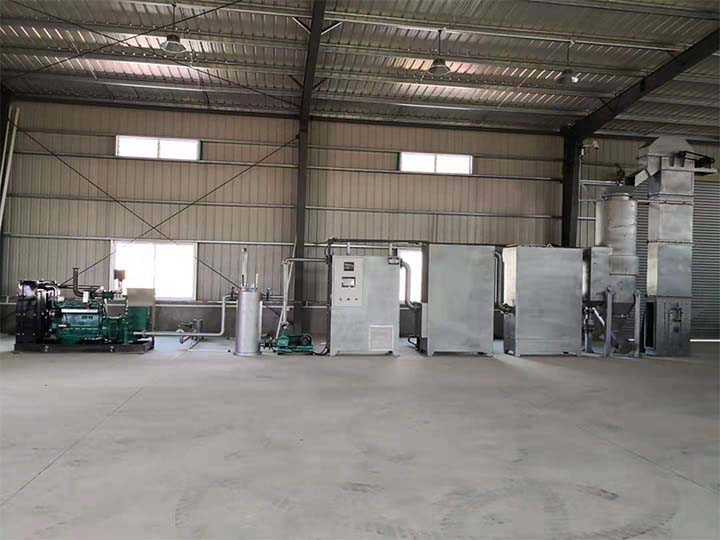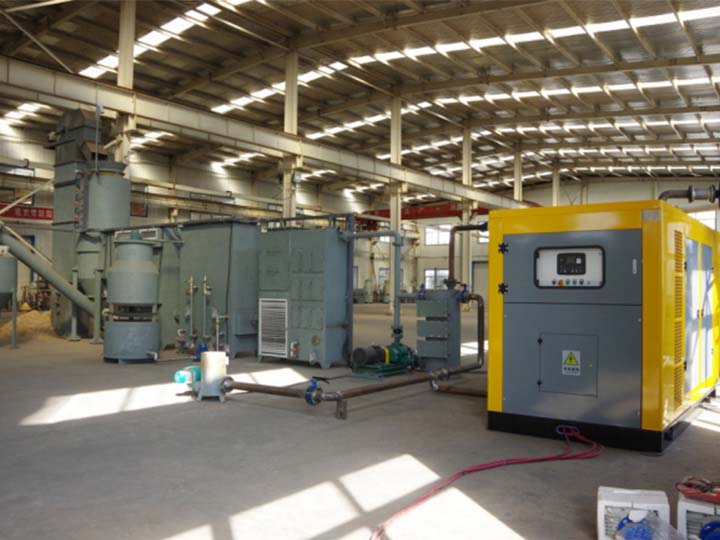바이오매스 가스 스토브에서 발생하는 가스는 친환경 신재생 에너지에 속하며 강한 생명력을 가지고 있습니다. 원료가 농작물 짚, 산림 폐기물, 식용 버섯 찌꺼기, 소, 양 및 가축의 분뇨와 모든 연소 가능한 물질이기 때문에 이는 고갈되지 않는 재생 가능한 자원입니다. 각 농부는 하루에 3-5킬로그램의 식물 원료만 있으면 하루 종일의 에너지 소비(요리, 난방, 샤워)를 해결할 수 있으며, 액화 석유 가스처럼 연소됩니다. 이는 전통적인 장작 스토브와 액화 석유 가스를 대체할 수 있으며 농촌의 연기 나는 생활 방식을 완전히 변화시킬 수 있습니다.
대부분의 농촌 지역에서 이용 가능한 고형 바이오매스의 양은 방대하며, 주로 농업 폐기물과 목재 폐기물로 구성됩니다. 바이오매스의 분포는 흩어져 있어 수집 및 운반이 어렵고, 대규모 연소 기술을 채택하기 어려워 중소규모 바이오매스 가스화 발전 기술이 독특한 장점을 가지고 있습니다.
작동 원리 바이오매스 가스화기
다양한 바이오매스의 반응 과정은 서로 다릅니다. 일반적인 가스화로 반응은 산화층, 환원층, 분해층 및 건조층으로 나눌 수 있습니다.
산화 구역과 환원 구역은 총칭하여 가스화 구역이라고 하며, 가스화 반응은 주로 여기에서 진행됩니다. 분해 구역과 건조 구역은 총칭하여 연료 준비 구역이라고 합니다.

- 산화 반응: 산화층에서 바이오매스의 주요 반응은 산화 반응입니다. 가스화제가 그레이트의 하부에서 도입되어 재층이 열을 흡수한 후 산화층으로 들어갑니다. 여기서 고온의 탄소는 연소 반응을 겪어 대량의 이산화탄소를 생성합니다. 열을 방출하며, 온도는 1000~1300도 섭씨에 이를 수 있습니다. 산화층에서의 연소는 발열 반응이며, 이 반응 열의 일부는 환원층의 환원 반응, 물질의 분해 및 건조를 위한 열원으로 제공됩니다.
- 환원 반응: 산화층에서 생성된 이산화탄소와 탄소는 수증기와 환원 반응을 겪습니다.
- 분해 반응 구역: 산화 영역과 환원 영역에서 생성된 고온 가스가 상승 과정에서 분해 영역을 통과하여 바이오매스를 가열하므로, 분해 영역의 바이오매스는 분해 반응을 겪게 됩니다.
- 건조 지역: 산화층, 환원층 및 열분해 반응 구역 이후, 가스 제품이 이 구역으로 상승하여 바이오매스 원료를 가열하여 원료의 수분이 증발하고 열을 흡수하여 생산 온도를 낮춥니다. 바이오매스 가스화로의 배출 온도는 일반적으로 100~300°C입니다.
바이오매스 가스화의 제품 성능
- 첨가제가 필요하지 않음: 그냥 어떤 인화성 물질이나 사용하세요.
- 환경 보호 및 에너지 절약: 2.1m3 연료 1킬로그램당 생성될 수 있는 가스의 양은 2-3킬로그램이며, 사용 중에는 연기와 먼지가 발생하지 않습니다. 매번 2-3킬로그램의 연료를 추가하면 가스를 90-180분 동안 지속적으로 사용할 수 있습니다.
- 안전 및 환경 보호: 낮은 작업 압력, 배기가스 없음, 폭발 위험 없음, 석탄 연소로 배출되는 배기가스로 인한 개인 부상 없음, 환경 보호.
- 서비스 수명: 사용자는 60분 이내에 분해 및 수리가 가능하며, 서비스 수명은 10-15년입니다.

바이오매스 합성가스 발전소의 제품 장점 바이오매스 합성가스 발전소
- 초강력 변환 시스템, 낮은 시작 열전달 온도 및 빠른 열전달 속도.
- 설치 비용이 낮고 난방이 안전합니다: 장비는 범용이며, 원래 난방 장비는 변경되지 않고, 파이프와 라디에이터는 범용이며, 물 순환을 사용하여 난방 효과를 달성합니다.
- 가열 속도가 빠르고, 가열 면적은 60-500 제곱미터에 도달할 수 있으며, 24시간 가열되고 서비스 수명이 깁니다.
- 다양한 원자재(곡물 껍질, 옥수수 줄기, 쌀 줄기, 밀 줄기, 참깨 줄기, 땅콩 껍질, 가지, 톱밥, 잡초 등) 모두 바이오매스 연소 가능한 농업 및 임업 폐기물입니다.
- 넓은 용도: 요리 및 조리, 난방을 위한 물 끓이기, 읍내 기업 및 식당, 도시 노점, 가축 사료 조리, 샤워, 온상 난방 등.
